Laurence meets a hoo or two!

As well as stunning gardens, the extensive grounds now include an 18 hole golf course that is maturing nicely.
Our editor meets the two men charged with the upkeep of the grounds
It's not often one gets the chance to visit an iconic mansion, and have a guided tour of the golf course and gardens by the respective Head Greenkeeper and Head Gardener, so an opportunity to do just that at Elite Hotels' Luton Hoo Golf & Spa was one not to be missed. Here, I was able to see how this historically important mansion had been transformed into an exclusive complex that now includes an 18 hole, 7,107 yard parkland golf course.
Over the years, Luton Hoo has counted many heads of state and members of royalty among its visitors, including Queen Mary, Edward VII and Lord Mountbatten. In 1947, the Queen and Duke of Edinburgh spent part of their honeymoon in one of the mansion's vast state bedrooms, and also returned to celebrate future wedding anniversaries.
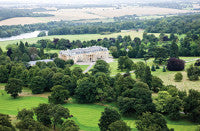
In 1903, Luton Hoo was bought by Sir Julius Wernher, owner of the Kimberley Diamond Mines in South Africa, who commissioned Charles Mewes and Arthur Davis, the architects of the Ritz Hotel in London, to redesign the interior of the house in a lavish Edwardian Belle Époque' style. After the death of Sir Julius, Harold Wernher inherited the estate from his father.
During the Second World War, the estate and mansion house was commissioned by Eastern Command and played an important role in wartime operations, testing tanks before they were taken off to depots for war service.
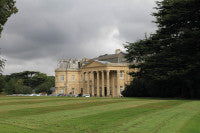
Sir Harold and Lady Zia decided to exhibit Sir Julius's art collection within the house in 1951, including several items of the now famous Fabergé collection. They also bred several well known racehorses, including Brown Jack, who won twenty five races in his ten year career and Charlottown, who won The Derby in 1966.
Sir Harold died in 1973, followed by Lady Zia in 1977, with the estate passing to their elder grandson and the Queen's Godson, Nicholas Phillips who, together with his wife, developed the living accommodation into facilities for corporate functions and filming, to support the maintenance of the art collection.
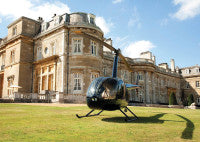
Following Nicholas Phillips death in 1991, the estate was put up for sale in 1997 and was finally purchased by Elite Hotels in 1999. The hotel opened in October 2007, following an investment of more than £60 million and a painstaking restoration programme.
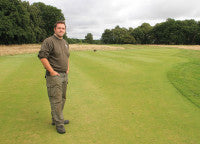
Not quite sure what the weather held in store, Avon and I agreed that, as rain was forecast later, we would tour the golf course first and meet up with Keith later in the morning.
Avon commandeered one of the many E-Z-Go golf buggies and we headed off to see the course, which is set in over 1,000 acres of Bedfordshire countryside. The house is set on top of a hill and the grounds fall away on all four sides. The whole topography of the site was influenced by the work of Capability Brown, who designed the gardens back in the mid 1700s, and he included a sixty acre lake which forms one of the main features of the estate.
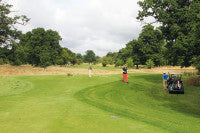
The course was designed by Mike Smith who styled the course in 300 acres around the established mature trees that had been historically planted around the mansion house.

During the summer, Avon employs one casual worker and uses the services of Consultant Agronomist, Peter Jones.
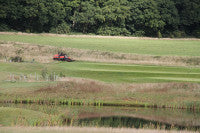
Avon manages his own budgets, reporting to the Estate Manager, and explains that it has been a case of building up the equipment to cope with the sheer size of the course. "We submit a draft budget each year for approval from senior management," he explains.
"The course covers 300 acres, split into three areas that we refer to as Jacksons Hill (the all new build), The Piggery (holes 13 through 17) and The Plain (holes 1,9,10 and 18)."

"Having plenty of space means there are quite large areas of rough to be managed," Avon continues. "These are maintained under different regimes. Some areas are cut every couple of weeks, whilst other parts are cut and collected twice a year."
"This year, we've hired an Amazone flail mower/collector to cut and collect areas of the rough. I'd like to purchase our own at some point in the future, to give me greater control on when we can do the work."
Larger swathes of rough are cut and baled by a tenant farmer for silage, creating in excess of fifty round bales!

The underlying soil profile is clay/clay loam, but packed full of flint from six inches down.
Irrigation water is collected and recycled through filters and a pumping system out on the course. Surface run-off is collected in three large man-made lakes, each with around fifteen million litres capacity. The water is kept circulating through the three lakes to keep it oxygenated. In the past, Avon used to add Becker Underwood's Black Onyx premium lake dye to help improve the quality of the water and to maintain a dark colour to aid appearance and reflections. However, this year, he is using a new blue dye to control algae.
"One of our recent projects was a redesign of one of our streams that allows water to flow between the lakes; this was widened, with some small waterfalls added as a bit of an attraction," says Avon.
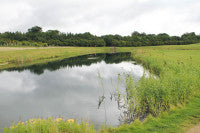
"Not having bunkers means that we can operate a dual irrigation system for the greens with 180 and 360 heads. Like all sand based greens, they are prone to leaching, so we've increased rates of fertiliser on the greens and tees on a little and often basis, which is supported by controlled release granular feeding programmes that also include micronutrients, amino acids and seaweed products."
Greens are cut daily using a Toro 3250-D, no lower than 4mm in the summer and at 5mm during the winter. The greens and tees are aerated with needle tines on a bi-monthly basis, whilst the fairways are aerated with a Wiedenmann Terra Spike every year using 18mm tines at 150mm spacings. Hollow tining and overseeding is carried out in March as this gives faster recovery due to the nature of the winters here. "The snow and frosts tend to hang around a bit longer here than the surrounding area," claims Avon.
As for topdressing, Avon has changed to a straight sand dressing to help alleviate the build-up of any thatch, applying, on average, around 90 tonnes a year on the greens. However, he is keen to invest in more material in the coming years and take his annual total up to around 120 tonnes.

"I like my staff to be multi-skilled so that each member of the team can carry out most tasks but, inevitably, each has a preferred job. Having no bunkers is a bonus as it means we have more time to spend on other parts of the course."
Playing difficulty is created by good tee and hole positioning, with the physical presence of both the rough and trees - many of them large and mature - often making it difficult to play a clear shot into the green.
The spacious tees have been cleverly designed to give a wide variety of lines of play. They are mown two or three times a week at 12mm using a Jacobsen TR3
The rough is cut at 35mm, semi rough at 25mm and the fairways are kept at 15mm. It usually takes around three hours to cut greens, six hours for tees and surrounds, and nine hours for the fairways. The rough generally takes between three or four hours depending on how fast things are growing. The long rough gets cut and collected in late August, usually taking between three to four weeks to complete.
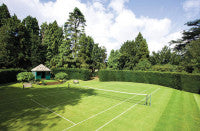
With so many mature trees on the course, most of the winter work is centred around tree works; crown lifting, thinning and dead wooding. One member of the greenkeeping team is a fully qualified tree surgeon and Avon is keen to train other members of his team to be chainsaw qualified. If there is a large amount of tree work to be undertaken, he can enlist the the help of qualified members of the gardening team. This work usually generates between 30-50 tonnes of firewood for the mansion each year.
"With the new plantations now over seven years old, we will begin thinning these out to allow trees to mature. I'm considering hiring a tree spade to transplant some of the larger trees to other parts of the course. "
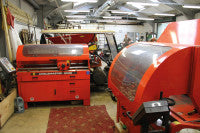
"Most of the servicing is done in-house and we have recently invested in two Bernhard grinders and do everything except for major repairs, i.e hydraulic pumps and valves, when we use a local dealer. The machinery was purchased new, but now we are looking at other options when it comes to replacing them. I'm not particularly loyal to one supplier as I prefer to buy, what I consider, the best for the job."
Finally, I ask how Avon communicates with the members. "I produce a monthly newsletter and am also setting up a Twitter feed so that they can get involved," he explains. "For example, this winter we are planning to put in some new paths and possibly some winter tees, so this will be the ideal way of keeping them informed."
"In truth though, there is no easier way to please members and to add interest than to keep the course as natural as possible. We've introduced wildflowers to some rough areas and plan doing more next year. Whilst we don't employ an environment consultant, we do work with local agencies."

Keith is a third generation head gardener, having followed his father and grandfather into the industry. Keith began his career at Luton Hoo as an eighteen old and progressed his way up to the position of Head Gardener.
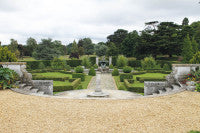
"We had managed on our own up until then; me outside, Zena inside. There was a big art collection, but that all got taken away to Ranger's House in London, which now houses the Wernher Collection and is managed by English Heritage. The family had other bits and pieces."
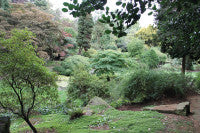
"Luton Hoo is lovely in the daytime, but if you see it in the evening with all the chandeliers and lights, it is spectacular," says Keith with considerable pride.
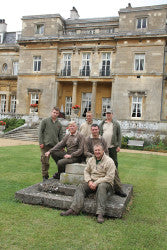
Surrounding the walled gardens are large herbaceous borders that are planted with the same varieties that have been seen at the house for generations. Keith and his staff re-propagate all the herbaceous plant to keep them supplied with new plant material. They do buy some annual bedding plants but, again, will propagate existing plants on site in their own greenhouses, where possible.
Keith has also helped design many of the new bedding and gardens seen around the new builds associated with the hotel, such as the coach house refurbishments, hotel bedroom extensions and flower garden block, all planted with a variety of groundcover, floral and tree specimens.
One of Keith's favourite parts of the estate gardens is the sunken rockery garden, a place that reflects peacefulness with water dripping on to rock caverns and planted out with a display of rock plants and ferns. This area is favoured for wedding photos
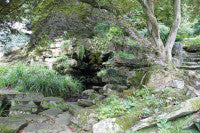
There is a lot of grass to cut around the house and driveways, and plenty of hedge cutting, which are cut once a year and take six weeks to complete.
There are also over seventy large, outdoor planters to be maintained during the height of the growing season, which are planted up with spring and summer bedding material, all of which are propagated and grown in-house. In total, Keith will grow around 5,000 annual bedding plants to meet the needs of the house and gardens.

Now, after fourteen years working for Elite Hotels, Keith can't praise them enough for their continuing investment in a truly historic house and gardens. His initial scepticism has been completely put to rest!
The future of Luton Hoo looks bright for all those who work there, and the addition of the golf course will only enhance the true quality of the estate for future generations to enjoy. Capability Brown would be mightily impressed.
What's in the greenkeepers' shed?
Toro 3250-D Greensmaster
Toro 5500-D Reelmaster
Toro HD Workman
Toro 1000 pedestrian mowers x 4
Toro Procore
Jacobsen LF-3400 fairway mower
Jacobsen AR-5 5 deck rotary mower
Jacobsen AR-3 3 deck rotary mower
Jacobsen TR-3 tees mowers x 2
John Deere 6x4 Gator
Trilo Leaf Vacuum
Wiedenmann Terra Spike
Bernhard Anglemaster 3000
Bernhard Express Dual 3000
Bernhard Rapid Facer 1000
Toro 200 mounted sprayer
Tycrop Propass topdresser
Jcb 354 tractor
McCormick GM45 front loading tractor
